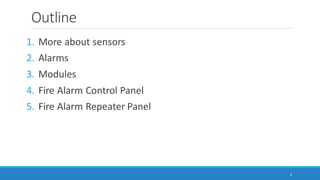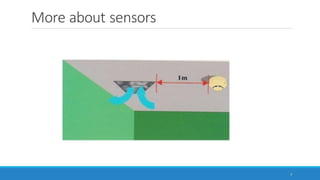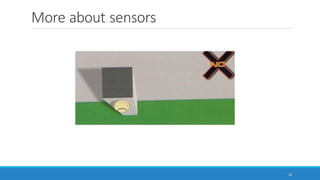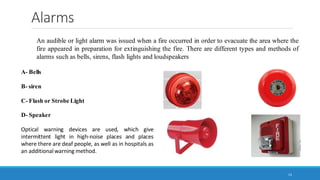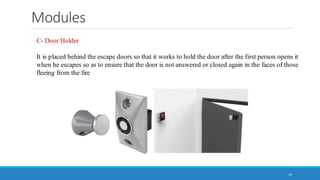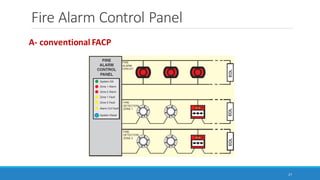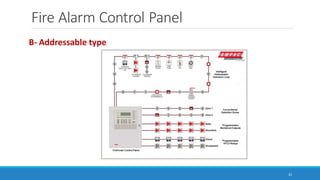Lecture 5 Fire Alarm System.pdf
- 1. Planning and Implementing Communications Systems in Residential and Non-Residential Buildings Dr. Abdelhay Ali
- 3. References Textbooks 1- Low Current Systems for Electrical Power Engineers by prof. Mahmoud Gilany 2- Light Current Systems Guide by Dr. Abd Almonem Shaban 3- Low-Current Systems Engineer'S Technical Handbook , A Guide to Design and Supervision" by Habbieb Mansour. Online classes at other schools Light Current Course 2021 Level#3 3
- 4. Outline 1. More about sensors 2. Alarms 3. Modules 4. Fire Alarm Control Panel 5. Fire Alarm Repeater Panel 4
- 5. Outline 1. More about sensors 2. Alarms 3. Modules 4. Fire Alarm Control Panel 5. Fire Alarm Repeater Panel 5
- 11. More about sensors 11 Manual Break Glass Also called the call points. Call PointIf a person sees the fire before hearing the alarm, he presses the call unit so that the siren goes off to warn of the presence of a fire.
- 12. More about sensors 12 Manual Break Glass
- 13. More about sensors 13 Manual Break Glass
- 14. Outline 1. More about sensors 2. Alarms 3. Modules 4. Fire Alarm Control Panel 5. Fire Alarm Repeater Panel 14
- 15. Alarms 15 An audible or light alarm was issued when a fire occurred in order to evacuate the area where the fire appeared in preparation for extinguishing the fire. There are different types and methods of alarms such as bells, sirens, flash lights and loudspeakers A- Bells B- siren C- Flash or Strobe Light D- Speaker Optical warning devices are used, which give intermittent light in high-noise places and places where there are deaf people, as well as in hospitals as an additional warning method.
- 16. Outline 1. More about sensors 2. Alarms 3. Modules 4. Fire Alarm Control Panel 5. Fire Alarm Repeater Panel 16
- 17. Modules 17 They are units that manage and control some operations such as the Control Module, Auto Dialer, Door Holder, Monitor Module, and A- Control Module It is used to control stopping or starting some operations during a fire, as it transmits a signal from the FACP main control panel to the device to be stopped or started during a fire, such as: - - Turn off the elevators. - Close some electrical panels - Operating the Smoke Exhaust Fan - Turn off the Fresh Air Fan because it helps to increase the fire
- 18. Modules 18 B- Monitor Module (M.M) The Monitor Module is an addressable unit used to monitor unaddressed units and can be used In addressing traditional systems to give it a title and thus can be combined in addressing systems as shown in the following figure
- 19. Modules 19 C- Door Holder It is placed behind the escape doors so that it works to hold the door after the first person opens it when he escapes so as to ensure that the door is not answered or closed again in the faces of those fleeing from the fire
- 20. Modules 20 D- Auto Dialer It is a communication device that contains a set of numbers to call the fire, ambulance and security services in the building.
- 21. Outline 1. More about sensors 2. Alarms 3. Modules 4. Fire Alarm Control Panel 5. Fire Alarm Repeater Panel 21
- 22. Fire Alarm Control Panel 22 The FACP controls the system, supplies it with the necessary voltage, and monitors its work, as the signal from the detectors reaches it, and it operates the bells, sirens and indicator lights. - It operates on a voltage of 220V-50Hz and is equipped with backup batteries that operate automatically in the event of a power outage for a period of not less than 24 hours, and it has a device that charges the batteries when the power returns. - It is equipped with the possibility of self-testing and gives an audio warning signal in the event of a failure in the panel or in any part of the system components, or in the event of a power outage or disconnection of the batteries. - Equipped with a key to give a general warning to evacuate the place. - Manual control to check and stop devices, fire signals, turn off alarms, and restart the system again. - It can disable the closed door control system.
- 23. Fire Alarm Control Panel 23 - The FACP fire panel is placed in the security room, if any, or the light current room, or in any visible place for easy detection of the locationof the fire. - It can disable the Fresh Air Fans, as well as the electric elevatorsby giving a signal to the. Control Module - The fire panel operates the Smoke Exhaust Fan as well as the fire pumps
- 24. Fire Alarm Control Panel 24
- 25. Fire Alarm Control Panel 25 Types of FACP A-Conventional type B- Addressable type C- Wireless Fire Alarm System
- 26. Fire Alarm Control Panel 26 A- conventional FACP It is an early warning system against fire that depends on a group of reagents connected to each other on a specific area (Radial System) and gives a warning on this area through which the security men move in this area and detect the location of the fire. - Detectors are connected to circuits, as well as alarm devices to other circuits, as shown in the following figure, noting that the number of detectors in a single circuit, the zone, should not exceed the number stipulated according to the manufacturer of fire panels. For example, the maximum number of reagents in the 32 zones is a detector according to Cooper, and also up to 30 detectors, according to Menvier. - In the traditional control system, each group of conventional fire detectors is connected to a separate electrical circuit called the Zone to monitor a specific area so that any detector from the group sends a signal to the control panel to warn of a fire without specifying the number or address of the detector that sensed the fire
- 27. Fire Alarm Control Panel 27 A- conventional FACP
- 28. Fire Alarm Control Panel 28 A- conventional FACP This system is used in buildings and small establishments and is characterized by a relatively lower cost. It is also used in less important areas because when a malfunction occurs in one of the detectors, all the detectors after it are out of service because it is an open loop (Open Loop). -
- 29. Fire Alarm Control Panel 29 A- conventional FACP -
- 30. Fire Alarm Control Panel 30 B- Addressable type - This system depends in its work on connecting a group of detectors with each other on a closed circuit (Closed Loop), so that each sensor or detector takes the numbers and names of the places in which it is located. Addressed control panel Knowing the location of the fire In contrast to the traditional control panel, all alarms operate. - Detectors and alarms, as well as monitoring and control units, can be connected to the same Loop circuit so that it does not exceed the maximum number of points in the circuit, which varies from one company to another and may reach 200 devices in some companies -
- 31. Fire Alarm Control Panel 31 B- Addressable type
- 32. Fire Alarm Control Panel 32 B- Addressable type
- 33. Fire Alarm Control Panel 33 C- Wireless Fire Alarm System It is an early warning system against a fire of the wireless type. It is used in the event that there are no pipes and cables, as in the case of old buildings or ancient buildings, in which any cracking is prohibited to lay cables or pipes, and it depends on a certain number of sensors.
- 34. Outline 1. More about sensors 2. Alarms 3. Modules 4. Fire Alarm Control Panel 5. Fire Alarm Repeater Panel 34
- 35. Fire Alarm Repeater Panel 35 This panel is used in the addressing system when there is a place far from the main panel and we want to control the alarm system in this place or monitor it from close and this distance may reach 2000 m. The Repeater Panel is placed in this place and linked to the main panel, thus dealing with the fire alarm system in this area through the Repeater Panel, knowing that the main panel is aware of what is happening, but not in detail.
- 36. Thanks 36



